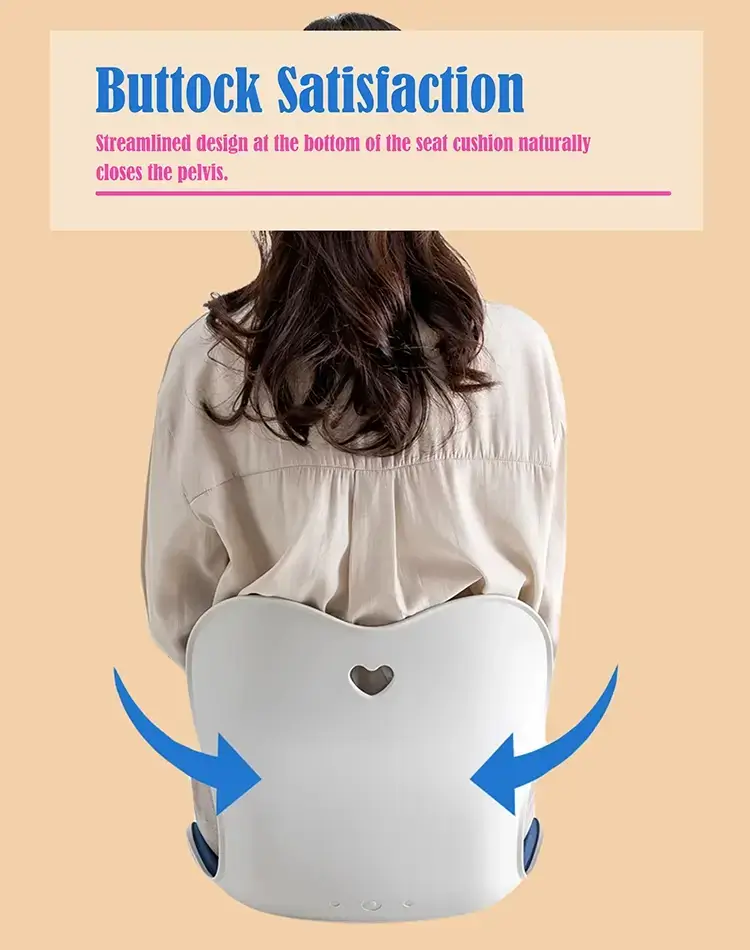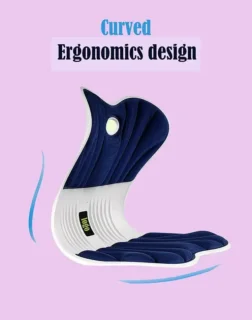5 Ways to Reduce Hip Pain When Sitting at Your Desk
In today's fast-paced world, whether you're a student, an office worker, or a busy parent shuttling kids to various activities, sitting for extended periods is an unavoidable part of life. However, this seemingly harmless habit can often lead to discomfort in your hip joints and the surrounding muscles. This discomfort can become more pronounced if you maintain the same seated position for an extended period. Courteney Kemp, PT, DPT, a dedicated physical therapist at Hinge Health, explains, "Whenever your hips are subjected to prolonged stillness, they can experience fatigue and tension, potentially resulting in irritation and reduced mobility."
Why Are My Hips Stiff After Sitting?
Understanding Hip Stiffness After Sitting: Insights from a Physical Therapist:
Experiencing stiffness in your hips after prolonged periods of sitting is not solely a consequence of aging. More often than not, this discomfort arises from maintaining the same seated position for an extended duration.
Kirsten Zambon, DPT, CLT-LANA, a seasoned physical therapist at Franciscan Health Lafayette East, sheds light on the matter: "When you sit with your knees bent, your hamstrings remain relaxed and in a shortened state, while your hip flexors reach their maximum shortened length. Hip pain stemming from prolonged sitting may result from poor posture, but if you find yourself seated for 40 to 50 hours per week, continuously for five to six months or longer, it's likely that your hip strength has diminished. When you eventually rise from your desk, you'll notice weakened glutes, core, and hip extensors, leaving you feeling less robust."
Understanding the Causes of Hip Pain While Sitting
Dr. Courteney Kemp, a respected expert in the field of orthopedics, underscores the significance of your hip joints, which play a pivotal role in supporting your body and facilitating leg movement. However, maintaining a stationary sitting posture for extended periods can generate tension within your hip joints and the surrounding musculature and connective tissues.
Numerous factors contribute to hip pain, especially during prolonged periods of sitting. It's important to note that gentle movements, coupled with appropriate stretching and strengthening exercises, can address each of these factors effectively.
- Sitting Position: While there is no universally "correct" sitting posture for joint and muscle health, Dr. Kemp emphasizes that remaining in the same seated position for extended durations—whether it involves crossing your legs, sitting on the ground, or reclining in an armchair—can subject your hip joints and surrounding tissues to additional stress. Although not inherently harmful, this stress may lead to discomfort in some individuals.
- Osteoarthritis: Aging brings about changes in everyone's body, including alterations in cartilage—the cushioning material surrounding your joints. While many people undergo cartilage-related changes without symptoms, others may experience irritation and develop arthritis symptoms like pain, stiffness, or swelling when confined to a constrained position, such as prolonged sitting. Dr. Kemp emphasizes that movement can effectively lubricate the joints and alleviate discomfort.
- Tendinitis: Tendinitis occurs when tendons, responsible for connecting muscle to bone, become irritated due to repetitive movements or acute injuries. Similar to osteoarthritis, Dr. Kemp suggests that muscular activity can mitigate inflammation, preventing stiffness and irritation in the affected area.
- Bursitis: Bursae are small sacs filled with fluid that serve as protective cushions between bones and soft tissues. Bursitis arises when these sacs become inflamed and swollen, potentially intensifying hip pain while sitting.
- Uneven Surfaces: Seating on surfaces that cause one side of your pelvis to elevate may increase tension in your hips, exacerbating discomfort during prolonged sitting for some individuals. Dr. Kemp advises that while sitting on perfectly flat surfaces isn't mandatory, it can be beneficial to be mindful of this potential contributor. In general, maintaining a seating surface that keeps your knees, hips, and pelvis relatively level can assist in managing hip pain during sitting.
By recognizing these underlying factors, individuals can take proactive steps to alleviate and prevent hip pain when sitting.
How Should I Sit To Reduce Or Prevent Hip Pain?
Dispel the Myth: Understanding Hip Pain and Prolonged Sitting
As a medical professional with extensive expertise in orthopedics, I want to clarify a common misconception: if your occupation requires extended periods of sitting, there's no need to obsess over creating the perfect ergonomic workstation or maintaining an ideal posture at all times. Contrary to popular belief, the act of sitting alone typically does not lead to hip pain. Instead, it's the prolonged maintenance of a static sitting position that frequently places undue stress on your hip joints and the associated connective tissues, potentially resulting in discomfort and pain.
The key takeaway here is that sitting, per se, is not the root cause of hip pain. It's the duration of immobility and lack of variation in your sitting position that may contribute to the development of hip discomfort. By acknowledging this distinction, individuals can adopt a more balanced and informed approach to mitigating the impact of prolonged sitting on their hip health.
Here are some ways to help minimize pain from sitting include:
1, Consider Embracing an Ergonomic Workstation
One significant challenge during our workday is the extended duration spent in a static sitting position. To address this issue, I recommend considering the adoption of an ergonomic workstation. It's important to note that this solution may take different forms for each individual, and you should customize it according to your specific requirements.
While certain companies may proactively introduce ergonomic workstation solutions to enhance employee productivity, those working from home enjoy more flexibility and autonomy to tailor their work environment to suit their needs to a certain extent.

When comparing professional ergonomic chairs to Back Bloom's Posture Correcting Ergonomic Chair, one key aspect to consider is the cost and portability.
Professional ergonomic chairs often come with a significant price tag, making them a substantial investment. In contrast, the Back Bloom Posture Correcting Ergonomic Chair offers an affordable alternative without compromising on quality and comfort.
Portability is another crucial factor. Traditional ergonomic chairs can be bulky and challenging to move around, limiting their flexibility. On the other hand, Back Bloom's chair is designed with portability in mind. Its ergonomic features are incorporated into a sleek and lightweight design, allowing you to easily transport and use it wherever you need support, whether in the office, at home, or even while traveling.
In summary, Back Bloom's Posture Correcting Ergonomic Chair provides a cost-effective and portable solution for those seeking the benefits of ergonomic support without breaking the bank or sacrificing convenience.
2, Take breaks to stretch
Don't underestimate the positive impact even a brief stretching break can have on your day. Dedicate just five minutes to stand up and stretch, or perform seated stretches for 10-30 seconds at your desk; these simple actions can significantly improve both your posture and overall well-being.
When addressing hip flexor pain associated with prolonged sitting, it's essential to incorporate movements that engage your hips while also tending to your back and leg muscles.
Consider standing up or kneeling on the ground to execute a gentle lunge stretch that encourages mobility in your hip area. However, exercise caution not to overexert yourself. Various gentle hip flexor stretches tailored for tight hips can provide immediate relief. The goal is to experience a mild stretch sensation akin to the refreshing stretches you might do upon waking in the morning, rather than inducing pain.
It's important to note that while sitting can lead to hip flexor tightness, excessive stretching immediately after prolonged sitting can potentially exacerbate discomfort. Therefore, we recommend gentle stretching in moderation to address hip flexor pain effectively. These stretches include:
Seated Hip Flexor Stretch
- Begin sitting upright in a chair.
- Move to the side of the chair, extending your leg back backward.
- Hold onto the chair or another sturdy object for balance
- Gently rock your pelvis forward to feel a stretch in the front of your hip.
Seated Hamstring Stretch
- Begin sitting upright in a chair.
- Straighten one leg.
- Lean your trunk forward, hinging at your hips until you feel a stretch in the back of your leg.
- Keep your knee straight during the stretch. Do not arch your back.
Seated Figure 4 Piriformis Stretch
- Sit upright in a chair with both feet on the ground.
- Bring the ankle of one leg up onto the knee of your opposite leg.
- Apply gentle pressure with one hand on the top of your bent knee
- Lean forward until you feel a stretch in your buttocks.
- Keep your shoulders relaxed and back straight during the exercises
3, Make time to go on walks and move your body
As previously emphasized, maintaining regular movement is essential for the well-being of your hip flexors. In an office setting, this can involve taking brief hourly breaks to engage in activities such as refilling your water, delivering mail across the building, or walking to a colleague's office to exchange information.
When working from home, you may have more flexibility to schedule breaks and incorporate physical activity throughout your workday. If you have a dog or young child at home, they can also benefit from these breaks.
Remember that your walks need not be lengthy; a short stroll around the block can suffice. The goal is to change the position of your iliopsoas muscles and engage in different activities periodically to prevent them from becoming excessively tight and prone to developing muscle knots or trigger points.
Strive to include at least two brief walks during your work hours, and consider incorporating targeted exercises or longer walks after completing your work for the day. This balanced approach will contribute to the health of your hip flexors and overall well-being.
4, Change up your sitting posture
It's worth reiterating that there's no universally "perfect" sitting position. The key is to diversify your sitting postures to reduce excessive strain on your hips. Aim to discover several comfortable positions that suit you and make a habit of altering your sitting posture regularly throughout the day. This proactive approach can significantly alleviate hip discomfort and support your overall well-being.
5. Prioritize Hydration for Joint Health
Staying well-hydrated is essential for your overall health and the well-being of your joints. Adequate hydration ensures your joints remain lubricated and receive essential nutrients. Dr. Kemp emphasizes the importance of maintaining hydration throughout the day. Additionally, drinking more water not only benefits your joint health but also encourages you to stand up more frequently for refills and bathroom breaks. These small actions may appear inconsequential, but they can have a significant impact on alleviating hip pain.
Of course, there are Additional Treatments for Hip Pain when Sitting, such as Over-the-counter pain medication, Pain relief creams, Ice or heat therapy, or Physical therapy, etc. But preventive exercise or sitting posture correction is the most important thing.
 What Makes Ergonomic Office Chairs Different?
What Makes Ergonomic Office Chairs Different?
Say Something!